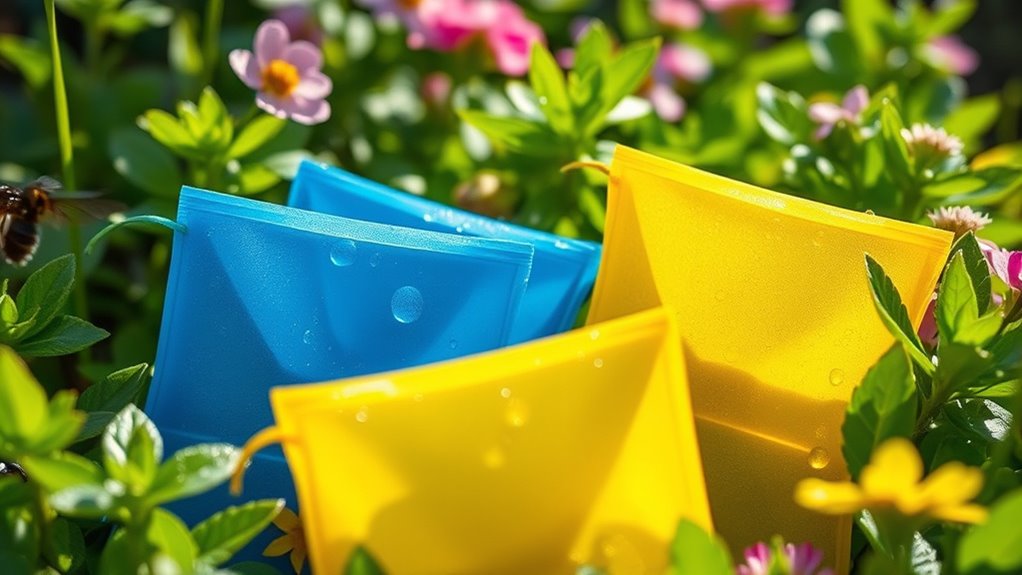Set your sticky traps early in spring to catch pests before they settle in, especially near entry points and high-traffic areas. During warmer months, keep traps in place consistently in kitchens, along walls, and around trash to target active pests like flies and ants. In fall and winter, reposition traps near warm spots like behind appliances or in storage areas to intercept pests seeking shelter. For expert tips on timing and placement, keep exploring these seasonal strategies.
Key Takeaways
- Set traps early in spring to intercept pests before populations grow during warmer months.
- Increase trap placement during summer when pest activity, like flies and ants, peaks.
- Maintain and check traps regularly in fall, focusing on indoor hiding spots as pests seek warmth.
- Reduce trap use in winter but keep them accessible in warm, pest-prone areas indoors.
- Adjust trap placement seasonally based on pest behavior and activity levels for optimal control.

As pests become more active throughout the year, knowing the best times to set sticky traps can make all the difference in controlling their population. Proper pest prevention starts with understanding when pests are most likely to seek food, water, and shelter, which directly impacts your trap placement strategy. During warmer months, pests like flies, ants, and cockroaches tend to be more active, so it’s essential to set traps early in the season to intercept them before they establish a strong presence. Placing traps in key areas such as kitchen corners, near trash cans, and along walls where pests often travel can considerably reduce their numbers.
In spring and summer, pests are highly mobile and reproduce rapidly, making this the prime time to focus on trap placement. You want to position sticky traps in high-traffic areas where pests are likely to pass through or settle. For example, near entry points like doors and windows, along baseboards, or behind appliances, you can intercept pests before they spread further into your home. Consistent trap placement during this time helps you monitor pest activity and gauge whether your pest prevention efforts are working. When setting traps, avoid cluttered areas so pests can easily find and stick to them, and check traps regularly to remove captured pests and replace them as needed. Additionally, understanding the seasonal activity patterns of pests can help optimize your trapping strategy for better results.
As temperatures drop in fall and winter, pest activity generally decreases, but some pests like mice or cockroaches may still seek shelter indoors. During these colder months, strategic trap placement becomes vital. Focus on areas where pests are likely to hide or find warmth, such as behind appliances, under sinks, or in storage areas. Since pest activity is lower, you might not need as many traps, but placing them in the right spots ensures you catch any intruders early. Keeping traps visible and accessible encourages pests to encounter them, supporting ongoing pest prevention even when activity slows.
Frequently Asked Questions
Can Sticky Traps Harm Pets or Children?
Sticky traps can pose risks to pets and children if not used carefully. To guarantee pet safety, you should place traps out of their reach and avoid areas where kids play. Keep traps in discreet spots, like behind furniture or high shelves, to prevent accidental contact. Always supervise children around traps, and educate family members about the potential hazards. Proper trap placement minimizes risks while keeping your home pest-free.
How Long Should I Leave a Sticky Trap in Place?
You should leave a sticky trap in place for about a week, depending on trap placement and pest activity. Regular trap monitoring helps you assess effectiveness and determine if pests are caught. Check the trap daily, especially in high-traffic areas, and replace it when it’s full or no longer catches pests. Proper trap placement and consistent monitoring guarantee you control pests efficiently without unnecessary replacements.
Are Sticky Traps Effective for All Pest Types?
Think of sticky traps as a net catching a fleeing fish; they work well for certain pests but not all. Their effectiveness depends on pest behavior and trap placement. You’ll find they trap flying insects like flies and moths, but not crawling pests like ants or cockroaches. For best results, place traps where pests are most active, and understand that some pests require different methods for control.
Can Weather Conditions Affect Sticky Trap Performance?
Weather conditions can considerably affect sticky trap performance. Climate considerations like humidity, rain, and extreme temperatures can cause traps to become less effective or reduce their durability. You should regularly check traps after heavy rain or heatwaves, replacing them as needed. By understanding these factors, you guarantee your traps stay sticky and functional longer, giving you better control over pest populations.
How Do I Dispose of Used Sticky Traps Safely?
You should dispose of used sticky traps carefully to avoid chemical exposure. Safely discard them by sealing the trap in a plastic bag and placing it in your trash bin. Check local recycling options, as some areas may accept the plastic for recycling, but avoid recycling the trap if it contains chemicals. Never burn or flush used traps, and always follow local disposal regulations to guarantee safety.
Conclusion
Now that you know the best times to set sticky traps, you can stay ahead of pests year-round. For instance, imagine noticing increased fly activity in early summer; setting traps then could prevent a larger infestation. By adjusting your trapping schedule seasonally, you stay one step ahead. Remember, timely placement is key to effective pest control. Stay vigilant, and your home will remain pest-free all year long.









